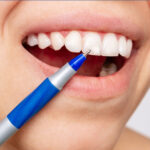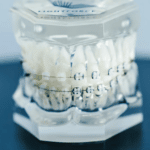Everything You Need to Know About White Spot Lesions
“Pearly whites” have long been the nickname for a set of impeccably clean teeth, but there’s a similar sounding term for a condition no braces wearer wants to hear: White spot lesions. Anyone who has gone through the braces experience knows what a milestone removal day can be, but these unsightly white spots can sour even the happiest of occasions. For those of you new to braces or anyone considering braces, read on as we dive deeper into what white spot lesions are, how to prevent them in advance, and what to do if you find yourself with them.
What are white spot lesions?
The unfortunate reality is that the hardware comprising a set of braces can become a haven for plaque to accumulate. In time, excessive plaque collection begins a decalcification process on the surface of the teeth that dissolves the minerals in the tooth enamel. This happens because plaque secretes an acidic waste that gives off a chalky, white appearance. The surface of the teeth covered by the hardware remains protected, which means it is not subject to the same collection of plaque. Once the braces are removed, the difference between what was covered and what wasn’t becomes apparent with white outlines shining through.
How to prevent white spot lesions
The good news is that with a little dedication and a commitment to proactive care, preventing white spot lesions may be easier than you think. The first step in doing so is to meticulously brush your teeth after every meal and before bed. Be sure to pay close attention to the gum line, a spot often overlooked by brushers in a hurry. It’s recommended that an orthodontic toothbrush is used because it allows the braces wearer more flexibility to move within the hardware, ensuring all crevices are properly addressed.
In addition to brushing, it’s essential that you floss and use a fluoride rinse daily. These tactics can loosen any nagging remnants of food or plaque that brushing fails to reach. Lastly, avoid consuming excessive amounts of sugar or acidic beverages like soft drinks, and visit your dentist every three to six months for a cleaning and an application of topical fluoride or a protective varnish.
What happens if you still get white spot lesions?
It’s important you know that white spot lesions are not always reversible, and attempting to do so may require some pretty extensive work. On the easier end of things, your dentist may suggest a prescription-strength topical fluoride rinse to wash the chalky substance away. With more hard-to-remove white spot lesions, microabrasion—or the gentle removal of a thin layer of your teeth’s surface enamel—or bleaching/whitening of your teeth may be needed. Your dentist may even suggest a combination of these approaches, like pairing microabrasion with whitening. The worst-case scenario is that you may need custom porcelain veneers, which can be pricey.
There’s a lot of maintenance that goes into wearing braces—but as you read here, that kind of preventive care can go a long way toward helping someone achieve the smile of their dreams. If you or a loved one have any questions about necessary maintenance and hygiene associated with wearing braces, we can help. Make an appointment with Dr. Angeloni today.


